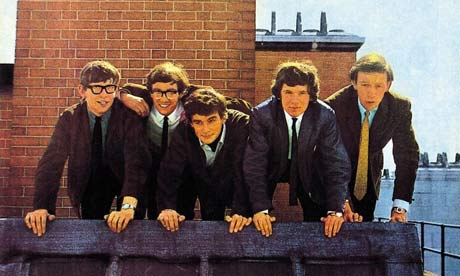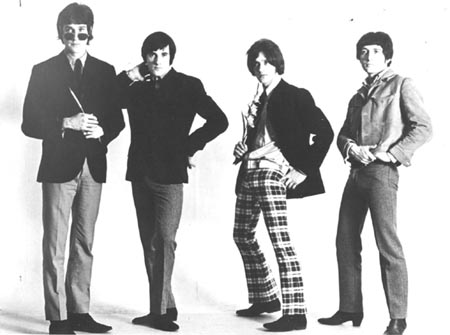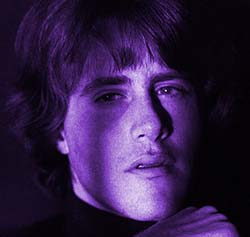The Zombies - Odessey and Oracle
(1968)
 Tracks
Tracks
1 Care of Cell 44 3:56
2 A Rose for Emily 2:19
3 Maybe After He's Gone 2:33
4 Beechwood Park 2:43
5 Brief Candles 3:30
6 Hung Up on a Dream 3:01
7 Changes 3:19
8 I Want Her, She Wants Me 2:51
9 This Will Be Our Year 2:08
10 Butcher's Tale (Western Front 1914) 2:47
11 Friends of Mine 2:17
12 Time of the Season 3:33
Often heavily overshadowed by more illustrious names from popular culture;
The Zombies from St Albans were in many ways one of the finest groups to come out of England during the mid sixties. Many people will know the band for their two enormous singles
She’s Not There from 1964 and
Time of The Season from 1969, and of course those people will be content with such knowledge and that empty five year space between songs. However we Cellar Dwellers know that there was more to this band than just two singles, we know of a piece of work called
Odessey and Oracle quietly released in 1968.
After an early burst of interest in the mid sixties, all went rather quiet on The Zombie front. Now being left for “dead” by bands like
The Beatles, and pushed to one side by the likes of
The Who and
Cream;
The Zombies initially sort to rediscover that initial single success. But by 67, priorities for some bands in British music had shifted somewhat from the need to create that sellable three minute single to the lust to craft the ultimate 35 minute album instead, and certainly
The Zombies spotted this development and seized upon it.
Work began on
Odessey and Oracle in Spring 67, the date and venue was very significant indeed for
The Zombies and this album generally. Entering the EMI studio on Abbey Road straight after
The Beatles had recorded a groundbreaking album of their own, using revolutionary techniques and equipment, conveniently saw
The Zombies gain access to the most advanced recording methods and engineering team in the world at that time, an opportunity not wasted by St Alban’s finest.
It’s no overstatement to suggest that this album is one of those few albums that really manages to hold a consistency musically close to the mark of perfection. The band’s command of both Baroque Pop and Psychedelia on
Odessey and Oracle is quite staggering. It should also be said that Colin Blunstone’s vocal style was always excellent for
The Zombies, but added to this musical backdrop, he blossoms and excels himself to take the songs to unparalleled heights.

I have quite a number of songs which I genuinely adore on this record; the opening song is called
Care of Cell 44 which cleverly puts the girl in prison and the boy writing the letter, this song’s style encapsulates all that is good about this album. The layers of sound and the way it just soars musically really does put you in a happy place. The next song is entitled
A Rose for Emily, it’s a change of pace from the opener but is well worth a visit each time the album is played just for its beauty more than anything. This song alone demonstrates how wonderful
The Zombies were at harmonising, but also gives Blunstone the chance to show the depth and quality of his voice.
At the moment I cannot get enough of track number six, entitled
Hung Up On A Dream, it’s a remarkable effort, perhaps more so because you never really realised such a song could have been recorded. Sure I’ve become very fond of Psychedelia over the years, particularly the British form, listening to bands like
The Kaleidoscope have ensured I will always have a taste for quality groovy tunes, but this song is something else. Sure the lyrics are typical ‘67, but the quality of the production and the structure of it takes this song to places I never really thought possible.
The last song recorded on this album was
Time of The Season, this song is obviously brilliant, soulful and beautiful to the end, but it has much more significance than just its qualities. It was not only the last song recorded on the album, it was also the last the band recorded for a very long time, as they split soon after. This song was released as a single two years later following its unearthing inclusion on a compilation album featuring other artists too, and it proved to be a huge standalone and retrospective success for
The Zombies.

It’s quite ironic that this single probably sold more in 1969 alone, than the album
Odessey and Oracle had done for a good decade after its creation. Thankfully though Cellar Dwellers, 40 years on, we now know that
Odessey and Oracle is the lasting legacy that The Zombies’ thoroughly deserved, and although a dud back in the day, it now can easily be entertained as one of the great albums of all time, which I happen to think it just might be.























 Linear Mode
Linear Mode
